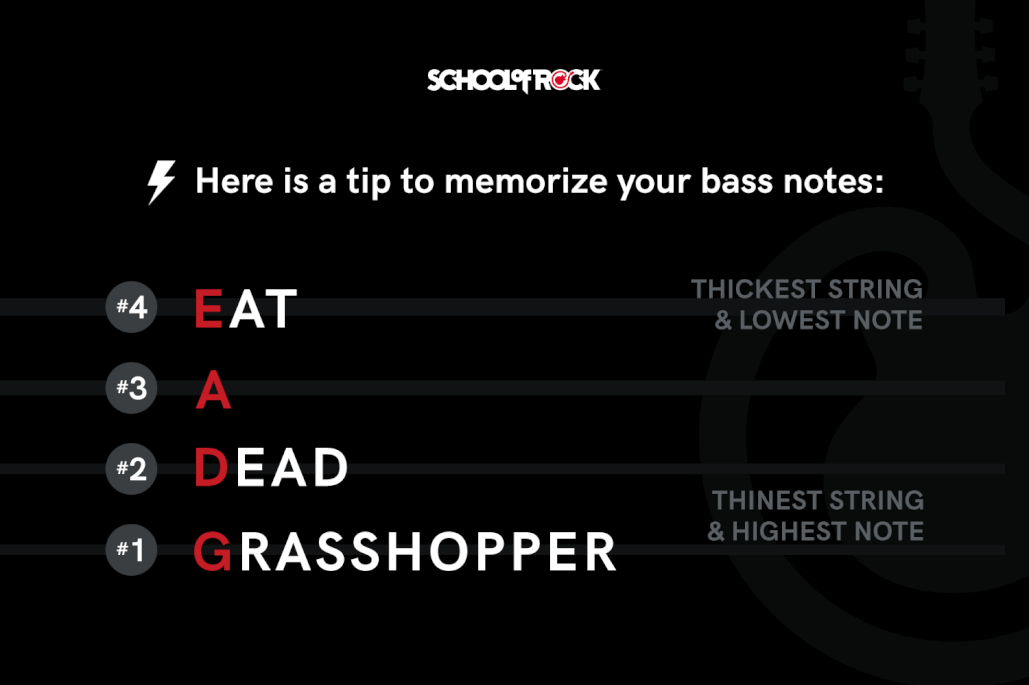When first starting to play, learning how to tune a bass guitar is one of the first skills a beginner needs. No matter how hard you try, you just can’t make an out-of-tune bass sound “right.”
Regular practice is essential to learning an instrument and knowing proper bass tuning makes practice much more fun and rewarding, especially when you’re learning the School of Rock way and playing with other instruments. It’s now easier than ever to tune your bass guitar and keep it in tune.
The basics of tuning your bass guitar
First, let’s start with some of the basic parts of the bass. Bass tuning is controlled by the tuning pegs on the headstock of the bass. Turning the pegs changes the pitch by tightening or loosening the string. Tightening the strings makes the pitch go up; loosening the strings makes the pitch go down.
How often should you tune your bass guitar?
You should tune your bass every time you play it. You can’t expect your bass to always stay in tune between practice sessions. As a general rule, basses stay in tune easier than a regular guitar, but you still want to check your tuning every time you play.
If it doesn’t sound quite right when you are playing, or if it sounds “off” when playing along with recordings, it is a good idea to check your standard tuning for a bass guitar.
HOW TO TUNE A BASS GUITAR
There are two common methods for tuning a bass guitar.
- Tune the bass guitar notes by ear. Play a “reference note” from another instrument, tuning fork, or pitch pipe and adjust your strings accordingly.
- Use an electronic or clip-on tuner. You can also buy and use an electronic tuner for your bass to adjust your strings.
TUNING YOUR BASS GUITAR WITH A CLIP-ON ELECTRIC TUNER
Clip-on electric tuners have revolutionized bass guitar tuning. Unlike old-fashioned electric tuners that you must plug into, clip-on electric tuners attach to your guitar’s headstock and sense the vibrations of the strings. They will tell your bass guitar’s notes are “flat” (too low), “sharp” (too high), or in tune.
Some tuners may have difficulty picking up the E string (lowest note). When buying a tuner, check to see if it can easily read the low string. These tuners are inexpensive, easy to use, and always accurate. Many practice amplifiers also feature built-in tuners as well.
HOW TO TUNE A BASS GUITAR WITHOUT A PITCH TUNER
You have multiple options to choose from when tuning a bass guitar.
DOWNLOAD A TUNER APP ON YOUR SMART DEVICE
You can find hundreds of tuner apps available for mobile devices, many are even free. These apps use your mobile device’s built-in microphone to hear the pitch of the strings. As you adjust the tuning peg for each bass string, the display on your device will tell you when you are in tune.
USE ANOTHER INSTRUMENT AS REFERENCE
You can also tune a bass guitar using a reference pitch from another instrument like a piano that you know is in tune. This is a little more difficult since you must tune one of your strings to the reference pitch “by ear.” This involves listening to the reference pitch, playing the same note on the bass, and comparing the pitches.
Adjust your note to match the reference pitch. Once you have one string in tune, you can then tune the bass to itself by playing a fretted note on a lower string and then tuning your open string to match that note.
Bass Guitar Tunings You Need to Know
STANDARD BASS GUITAR TUNING

If you’re playing a standard bass guitar, you will notice that your bass has only 4 strings. The standard bass guitar tuning for a 4-string bass is E, A, D, G (the same as the four lowest strings on the guitar but one octave lower). The bass strings are tuned in fourths.

5-string bass guitar tuning
5 string basses are becoming more common. They can be tuned by adding an extra low string B, E, A, D, G or by adding a high string E, A, D, G, C. Unlike the guitar which has most of its strings tuned in 4ths and one string tuned to a 3rd, bass tuning is generally done in all 4ths.
6-string bass guitar tuning
If you really want to expand your tonal range, try a 6-string bass guitar. 6-string basses add both an extra low string and an extra high string: B, E, A, D, G, C.
Drop D tuning for bass guitars
There are simple ways to expand your sound without adding extra bass strings. Drop tunings became popular in the ’90s for heavier music. Drop tuning is when you lower the pitch of your lowest string, usually a whole step below standard.
What is drop D tuning?
Drop D tuning is done by lowering the E string a whole step down to D. This makes the D note a fifth below the next highest bass string. This expands the tonal range of the bass and sounds “heavy.”
Tips for drop D tuning
Drop D tuning is extremely popular: D, A, D, G.
Metal bands often tune down even lower to drop C: C, G, C, F and some bands even use drop B: B, F#, B, E.
Drop D tuners
In situations where you need to be able to go back and forth between standard tuning for a bass guitar and drop tunings, drop D tuners are especially useful. These bass tuners allow you to change the tuning on the fly without having to use a tuner.
How to keep your bass guitar in tune longer
Once your bass guitar is in tune, there are three things you can do to keep it in tune longer.
- Change your strings often. Change your bass strings when they start to sound dead or have trouble staying in tune. When you change strings, be sure to stretch your new strings. You can do this by playing or by gently pulling up on the strings (be careful and don’t pull too hard or they will break.)
Because of the heaviness of the string gauges, basses are generally more stable than guitars and as a result, they are easier to keep in tune. Bass strings will also generally last much longer than guitar strings. If you are playing often and like your bass guitar notes to sound bright, you may want to change your strings monthly. Others prefer the sound of broken-in bass strings, but most players find that they should last several months. - Keep your bass clean. To keep your bass strings sounding fresh, wash your hands before playing and wipe your strings down when you are done jamming.
- Keep your bass protected in its case. When you are done playing, keep your bass in its case or bag to protect it from the elements. Try not to expose your bass guitar to big fluctuations in temperature or humidity.
Whether you use an electronic tuner or tune “by ear,” if you follow these simple steps, you will have a guitar that is in tune, stays in tune, and is far more fun to play.
Get Ready to Rock Out with Bass Lessons from School of Rock
Now that you know the ins and outs of tuning your bass guitar, you’re ready to take the next important step and learn to play the bass like all the famous bassists who came before you. We provide a wide range of bass lessons that easily walk you through every step of learning to play the bass that are suited to beginner, intermediate, and even expert levels. Discover and unleash your inner bassist with School of Rock today!






